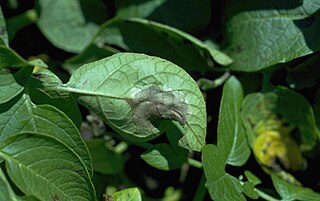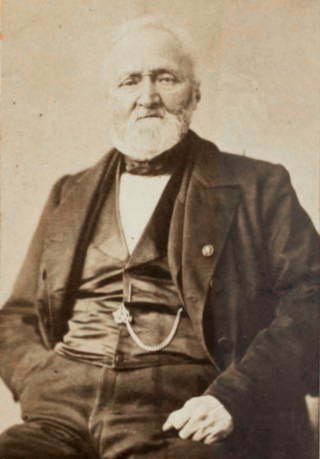
Rusts are fungal plant pathogens of the order Pucciniales causing plant fungal diseases.

Phytophthora infestans is an oomycete or water mold, a fungus-like microorganism that causes the serious potato and tomato disease known as late blight or potato blight. Early blight, caused by Alternaria solani, is also often called "potato blight". Late blight was a major culprit in the 1840s European, the 1845–1852 Irish, and the 1846 Highland potato famines. The organism can also infect some other members of the Solanaceae. The pathogen is favored by moist, cool environments: sporulation is optimal at 12–18 °C (54–64 °F) in water-saturated or nearly saturated environments, and zoospore production is favored at temperatures below 15 °C (59 °F). Lesion growth rates are typically optimal at a slightly warmer temperature range of 20 to 24 °C.

The Oomycetes, or Oomycota, form a distinct phylogenetic lineage of fungus-like eukaryotic microorganisms within the Stramenopiles. They are filamentous and heterotrophic, and can reproduce both sexually and asexually. Sexual reproduction of an oospore is the result of contact between hyphae of male antheridia and female oogonia; these spores can overwinter and are known as resting spores. Asexual reproduction involves the formation of chlamydospores and sporangia, producing motile zoospores. Oomycetes occupy both saprophytic and pathogenic lifestyles, and include some of the most notorious pathogens of plants, causing devastating diseases such as late blight of potato and sudden oak death. One oomycete, the mycoparasite Pythium oligandrum, is used for biocontrol, attacking plant pathogenic fungi. The oomycetes are also often referred to as water molds, although the water-preferring nature which led to that name is not true of most species, which are terrestrial pathogens.

Phytophthora is a genus of plant-damaging oomycetes, whose member species are capable of causing enormous economic losses on crops worldwide, as well as environmental damage in natural ecosystems. The cell wall of Phytophthora is made up of cellulose. The genus was first described by Heinrich Anton de Bary in 1875. Approximately 210 species have been described, although 100–500 undiscovered Phytophthora species are estimated to exist.

Joseph Charles Arthur was a pioneer American plant pathologist and mycologist best known for his work with the parasitic rust fungi (Pucciniales). He was a charter member of the Botanical Society of America, the Mycological Society of America, and the American Phytopathological Society. He was an elected member of both the American Philosophical Society and the American Academy of Arts and Sciences. He was a recipient of the first Doctorate in Sciences awarded by Cornell University. The standard author abbreviation Arthur is used to indicate this person as the author when citing a botanical name.

Stem rust, also known as cereal rust, black rust, red rust or red dust, is caused by the fungus Puccinia graminis, which causes significant disease in cereal crops. Crop species that are affected by the disease include bread wheat, durum wheat, barley and triticale. These diseases have affected cereal farming throughout history. The annual recurrence of stem rust of wheat in North Indian plains was discovered by K.C. Mehta. Since the 1950s, wheat strains bred to be resistant to stem rust have become available. Fungicides effective against stem rust are available as well.

Elvin Charles Stakman was an American plant pathologist who was a pioneer of methods of identifying and combatting disease in wheat. He became an internationally renowned phytopathologist for his studies of the genetics and epidemiology of stem rust. Stakman is credited with improving crop yields both in North America and worldwide as part of the Green Revolution.

Mikhail Stepanovich Voronin, also Woronin was a prominent Russian biologist, a botanist with particular expertise in fungi.

Julius Oscar Brefeld, usually just Oscar Brefeld, was a German botanist and mycologist.

The Jardin Botanique de l'Université de Strasbourg, also known as the Jardin botanique de Strasbourg and the Jardin botanique de l'Université Louis Pasteur, is a botanical garden and arboretum located at 28 rue Goethe, Strasbourg, Bas-Rhin, Alsace, France. It is open daily without charge.

Jean Pierre François Camille Montagne was a French military physician and botanist who specialized in the fields of bryology and mycology. He was born in the commune of Vaudoy in the department of Seine-et-Marne.

Joseph-Henri Léveillé was a French physician and mycologist who was a native of Crux-la-Ville, in the department of Nièvre.
Victor Fayod was a Swiss mycologist who created an influential novel classification of the agaric fungi and described a number of new genera and species.

Worthington George Smith was an English cartoonist and illustrator, archaeologist, plant pathologist, and mycologist.

Eduard Fischer was a Swiss botanist and mycologist.
Ernst Hallier was a German botanist and mycologist.

Marie-Anne Libert was a Belgian botanist and mycologist. She was one of the first women plant pathologists. She is sometimes referred to as "Anne-Marie Libert".
Heinrich Georg Winter was a German mycologist.

Jakob Eriksson was a Swedish plant pathologist, mycologist and a taxonomist. Eriksson was the first to describe the special forms within morphologically similar species of rust fungi. He has over 400 publications on studies primarily focusing on fungal pathogens at the cellular level and understanding the process of infection.
Plant pathology has developed from antiquity, but scientific study began in the Early modern period and developed in the 19th century.

















